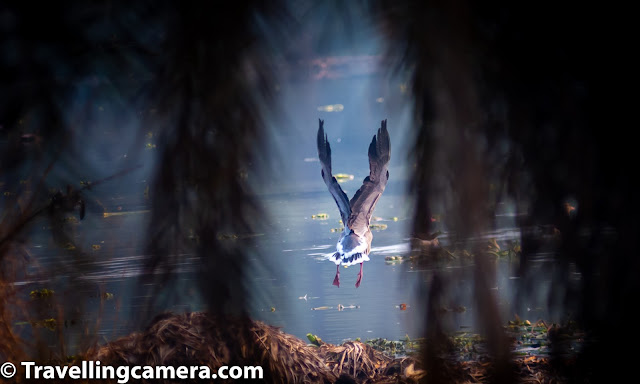 |
| Greylag Goose |
If you are interested in spotting migratory birds, now is the best time. And the best part is that you do not even have to go too far. Migratory birds can be spotted in any wetlands close to your home. While we were in Gujarat, we had seen cranes in fields on the side of the highway. Of course, none of these can actually match up to a full day Bharatpur experience, but they are good enough, especially if you have only a few hours in your hands and are close to a flooded field.
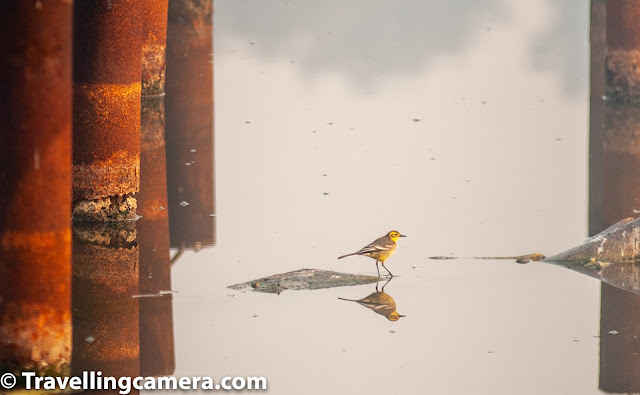 |
| Yellow Wagtail |
VJ and I are both birding enthusiasts. And we had been wanting to explore the wetlands in Surajpur for quite some time. This is a relatively smaller bird sanctuary with a trail that is about 2 kilometers in length. It goes around a central wetland and you have an opportunity to see migratory birds up close. And while you are at it, you can also probably spot quite a few resident birds as well.
Related Blogpost - Weekend Birding trip to Pong Dam from Delhi in Winters
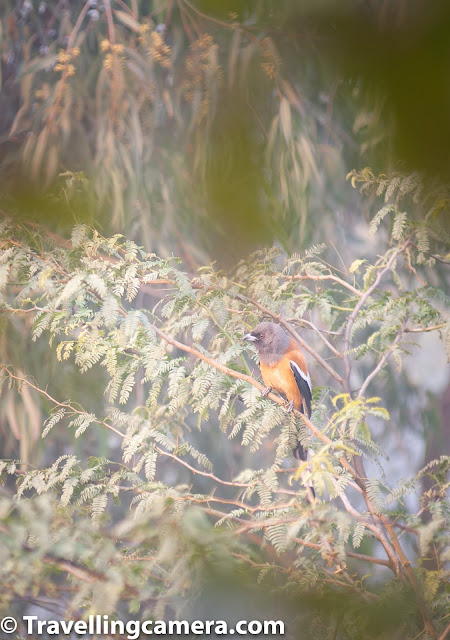 |
| Rufus Treepie |
The walk is even shorter than that inside the Okhla Bird Sanctuary, but the plus point is that the birds are up close and can be photographed much more easily. Also, the wetlands start as soon as you enter the sanctuary, unlike Bharatpur, where you have the walk considerable distance before you are able to spot big flocks of large birds.
Related Blogpost - Our trip to the Keoladeo National Park || An Overview
 |
| Black-winged Stilt |
However, this sanctuary is also at a great risk. The land around the sanctuary has been bought by some big builders, and small housing colonies are also coming up around the sanctuary. These residential areas are so close by that you can hear what people residing there are talking about in their houses. The presence of humans also brings stray dogs, some of whom have made the sanctuary their home.
Related blogpost - Birds of Ayuthhaya || 10-Day Vacation in Thailand
 |
| Black-winged Stilts |
As if the noise and encroachment wasn't enough, we also saw some drains flowing into the water of the wetlands, and we hope that it is treated water that is being let into the sanctuary. We also noticed electric fences around the sanctuary, which does not seem like such a great idea. Blue bulls (neelgai) often cross this fence and may end up hurting themselves.
Related Blogpost - Incredible Birds of Costa Rica || Hummingbirds
 |
| Black-winged Stilt |
Things seem to be headed towards a disaster, but there is still time to avert it. If the authorities take action, these wetlands can still be saved. A large number of migratory birds still manage to find their way to this sanctuary, so that is a good sign. The wetlands also houses a considerable population of neelgai, so that is another good thing.
Related Blogpost - Incredible Birds of Costa Rica || Motmots, Toucans, Trogons, Quetzals, and Macaws
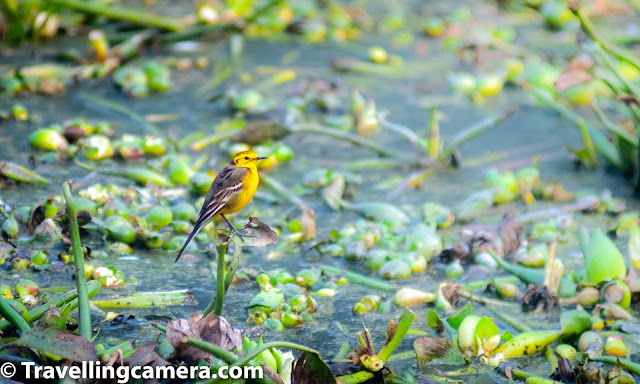 |
| Yellow Wagtail |
Anyways, on previous Saturday morning, we woke up early and headed out towards Greater Noida. It was here that we had to pick up our friend who was to be our guide. Let me take a few minutes to talk about this gentleman. He is an entrepreneur and a photographer with a deep-rooted interest in birding. He splits his time between India and the US and while he is in India, he ends up visiting the Surajpur Bird Sanctuary almost every alternate weekend.
Related Blogpost - Incredible Birds of Costa Rica || Woodpeckers, Flycatchers, Kingbirds, Tanagers, Parakeets, Sparrows, Finches, and Swallows
 |
| Marsh Sandpiper |
Not only this, he has also inculcated this love for nature and birds in his two young sons. In most of his visits, his sons accompany him. In fact the day he accompanied us, his family was travelling and did not know about his visit. He was sure they would have protested loudly had they known. It is quite heartening to see young children preferring to visit a bird sanctuary instead of a mall.
Related blogpost - Incredible Birds of Costa Rica || Flycatchers, Warblers, Solitaires, Jays, Egrets
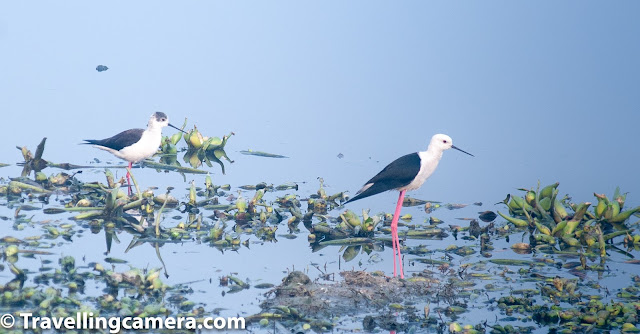 |
| Black-winged Stilts (the one with the black spot on head is the female) |
One important thing to know when you head to the Surajpur Bird Sanctuary is that you need permission from the DFO to enter. You can visit their website to and check out the contact details there or check with your birder friends, they are sure to have some clue as to how to get the permissions. This strictness is to ensure that only those who are really interested in birding get here. Otherwise the bird sanctuary was becoming notorious for lack of security.
Related Blogpost - Birding opportunities around Binsar Wildlife Sanctuary, Uttrakhand, India
 |
| Black-winged Stilt |
Unlike most other sanctuaries, there are no charges to visit this bird sanctuary. If you have the permissions, you can simply walk in. There are people who go there for bird photography, and others that go there simply for birding. They usually just carry a field guide and a pair of binoculars, and spend hours just looking at the birds. However, the lack of tickets and proper boundaries has its own drawback. There have been sporadic incidents of snatching and also extreme PDA here because of which some of the reviews say that this is not a family destination. However, after the strictness, all that is under control.
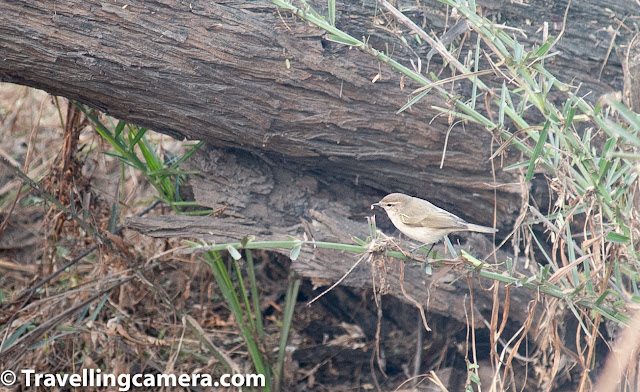 |
| Common Chiffchaff |
The first bird that greeted us as we entered Surajpur Bird Sanctuary was the Black-winged Stint. This bird looks really cute with its really long orange legs and black and white bodies. The female often has black spots on the head. The call is shrill and the bird mostly only calls during flight. The birds are social and are seen in close proximity of other waders near marshes, lakes, and even oceans.
Related Blogpost - In search of my winged friends at Okhla Bird Sanctuary, Noida (India)
 |
| Ruff |
Then we saw a flock of what we thought were gulls flying overhead. VJ managed to capture these in his camera. When we came back and looked at the pictures, these weren't gulls at all. These were Ruff. Females are known as Reeve. These are medium-sized waders and indulge in interesting migratory patterns.
Related blogpost - Birding in Dalhousie, Himachal Pradesh (India)
 |
| Black-winged Stilt |
Ruffs and reeves usually only get together during the breeding season. Males play no part in chick care and nesting, so they leave the breeding ground early and make a shorter flight for wintering. So most of the birds that winter in Britain are Males and all birds that winter in Kenya are female. Male ruffs have ornate plumage on the head before or during the breeding season and form leks to entice the visiting females.
Related Blogpost - Millions of Migratory Birds in Pong Wetland, Himachal Pradesh (India)
 |
| White-tailed lapwing |
Our birder friend mentioned that he had seen Greylag geese here but the birds seemed to be missing for now. We decided to start walking deeper inside the sanctuary to find them. In the meanwhile some small birds kept us company throughout our walk - flitting from bush to bush, keeping VJ on his toes in his attempt to click them. While large migratory birds are fascinating, I find these little ones trickier to identify and, therefore, more interesting to chase.
Related Blogpost - The Winged Models || Birds of Badahin, Mandi, Himachal Pradesh
 |
| Pond Heron |
The first small bird that VJ managed to capture a decent photo of was the restless Ashy Prinia. This bird is also known as the ashy wren-warbler and the southern population has distinct breeding and non-breeding plumage. The bird is easily identifiable by its long and often upright tail. It keeps flitting from branch to branch and is very difficult to photograph.
 |
| Ashy Prinia |
The Ashy Prinia in the North does not change its plumage. It has rufus underparts and dark brown head and wings. The Ashy Prinia's call is a short and snappy twee which it usually synchronizes with its rapid movements. Like most other warblers, the Ashy Prinia is insectivorous. The bird usually builds nests on the ground, even though the breeding actually officially starts from the top branch where start their mating rituals.
 |
| Great Cormorants |
This was when we spotted two Great Cormorants sitting on tree stumps in the middle of the wetlands. They were striking a great pose and had to be clicked. There are majorly three types of cormorants in India - Great Cormorant, Indian Cormorant, and Little Cormorant. The ones at Surajpur were all Great Cormorants.
 |
| Great Cormorant |
Great cormorants have black bodies, some white patches on the chest and a largish beak with orange splash. They are beautiful in flight, especially when they are starting their flights. They splash the water surface a few times before they take off. If you have ever skipped stones in lakes, you would know what I mean.
 |
| Yellow Wagtail (Female) |
Another little bird that was everywhere was the yellow wagtail. We saw it first from a distance, and then we kept seeing it everywhere. The birds were mostly in pairs and were rummaging around the hyacinth. They are known as wagtails for an obvious reason. They keep wagging their tails up and down incessantly. Usually they have yellow bellies but lighter, almost while plumage is also not unheard of.
 |
| Common Chiffchaff |
The common Chiffchaff or simply Chiffchaff is a leaf warbler which is a non-breeding migrant from up north. Looking at the bird and its size, it is hard to imagine that it migrates all the way from Russia and other northern countries every winter. The warbler has dark beak and legs and dark upper parts and almost whitish belly.
 |
| Ashy Prinia |
One bird that kept flitting in and out of our view was the Great Coucal. Every time, it was really far off though and we were not able to photograph it. It is a rather beautiful bird with black body and brown wings. It is a non-parasitic member of the cuckoo family, but is a very elusive bird, mostly observed at a distance. We had clicked this bird at Bharatpur. Click here to check it out.
We were now quite deep inside the sanctuary, but we were yet to spot the elusive Greylag geese. We kept walking and would soon come across some really pretty birds and some wildlife as well. But for that, please wait for part 2 of this post. Till then...


.jpg)
Comments